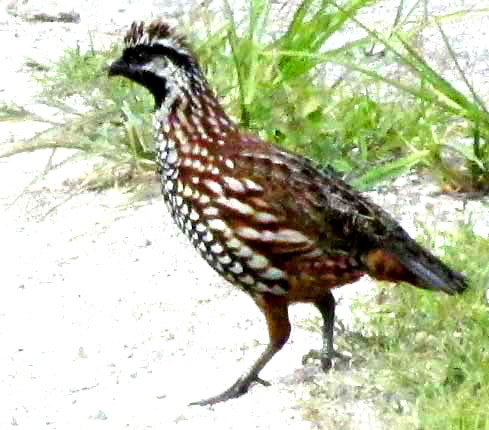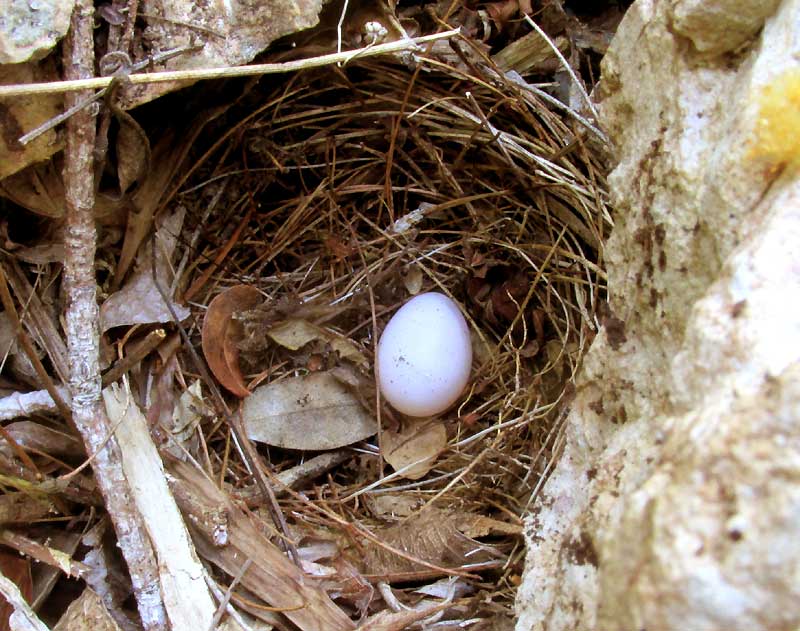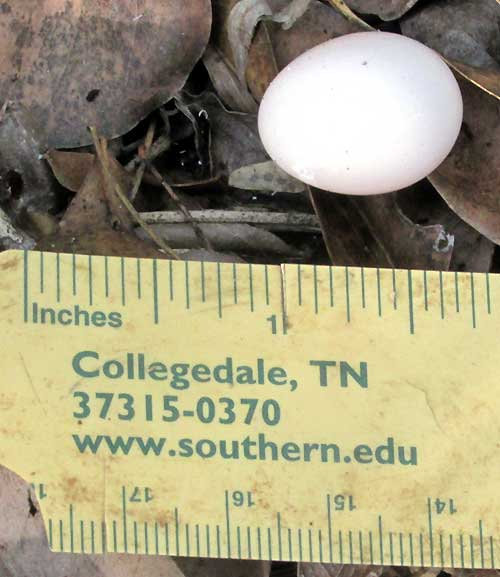Excerpts from Jim Conrad's
Naturalist Newsletter
from the November 23, 2014 Newsletter issued from Río Lagartos, on the Yucatan Peninsula's northern coast (~N21.60°, ~W88.16°), Yucatán state, MÉXICO
YUCATAN BOBWHITE
On a little one-lane, dirt road through the savanna south of town two bobwhites ran along in front of us looking as if they'd rather do anything than take flight. We stopped, one turned sideways to give us the eye, and I snapped the picture seen below:

If you have Northern Bobwhites in your area, they probably look different from this one, having white throats instead of black, and underparts not nearly as "black-edged scaly looking" as this one. However, if you're familiar with the Northern Bobwhite's remarkable regional variations over its large distribution area -- including completely black-headed ones with dark chestnut underparts in southern Mexico on the Pacific Slope -- then you might think that our Yucatan birds are just an extreme variation of the Northern Bobwhite. In fact, some experts think that that might be the case. However, most field guides do separate our Yucatan birds from the Northern species, referring to them as Yucatan Bobwhites, COLINUS NIGROGULARIS.
I love being down in the savannas in the mornings when the bobwhites are calling, their "bob-WHITE!" calls as sincere and clear sounding as I remember them back in the Kentucky countryside long ago. It's especially gratifying to hear them here because at my previous bases in Mississippi and Texas they've pretty much disappeared, presumably the victims of invasive fire ants. A study by CB Dabbert and JM Mueller available on a Texas A&M website reports that in their study in Texas, 38% of all mortality to bobwhite chicks up to 21 days of age was attributable to fire-ant stings at hatching. Though we have stinging ants here, I don't think they're fire ants, and they certainly aren't as numerous as in the US's fire-ant infested areas.
The Yucatan Bobwhite's distribution is an odd one. It occurs in brushy woodlands, overgrown fields and beach scrub throughout the northern and central Yucatan Peninsula, then there's a disjunct population in Belize, and yet another disjunct group in Caribbean Honduras and Nicaragua.
issued May 21, 2020 from the forest just west of Tepakán; elev. ~9m (~30 ft), N21.053°, W89.052°; north-central Yucatán state, MÉXICO
YUCATAN BOBWHITE NEST
Working along the rancho's boundary stone wall, in a certain spot several limestone rocks had fallen into a heap. Removing one of them, I found the nest shown below, situated on the ground beneath where the stone had been.

I supposed that the single egg in the nest was just the beginning of a clutch with several eggs, and felt bad about disturbing the nest, knowing that the mother might now abandon it. I replaced the rock roof, though I hadn't really noticed which rock it was and how it was situated. The next morning the egg was missing, except for a small fragment of shell. However, as I continued my work along the wall, about 20ft away, I saw an egg like the one previously inhabiting the nest. I guessed that the mother had arrived to lay her second egg, saw that the nest had been discovered, possibly ate the egg to recycle nutrients, then walked into the forest and dumped in a random, highly visible spot the egg she needed to lay. That second egg is shown below:

The ruler is there because I wanted to identify the nest and egg. It looks like the egg is about 20mm long (1-5/16ths inch). Now, relatively few birds lay their eggs on the ground. When consider the published egg descriptions of those species found in the Yucatan, all of them are disqualified because of color, markings, shape or size -- all except for the Yucatan Bobwhite, for whom Steve Howell in his 1995 guide describes as "clutch in wild undescribed (?), eggs white." Considerable searching on the Internet turned up no further nest/egg information.
However, some authorities consider the Yucatan Bobwhite, Colinus nigrogularis as a mere subspecies of North America's Northern Bobwhite, Colinus virginianus, and our nest and eggs match Northern Bobwhite pictures found on the Internet. Especially the size and coarseness of straws used in the nest, and their neat fitting together are convincing features. Also convincing is that each morning as I work in the general area of the nest, a Yucatan Bobwhite calls from an abandoned field about 100 m (yards) away.
So, maybe we're providing new information here. The nest was in a regenerating thornforest, with enough tall trees to be considered a shady forest, the main trees being Senegalia [Acacia] gaumeri, Pithecellobium dulce and Vachellia [Acacia] collinsii